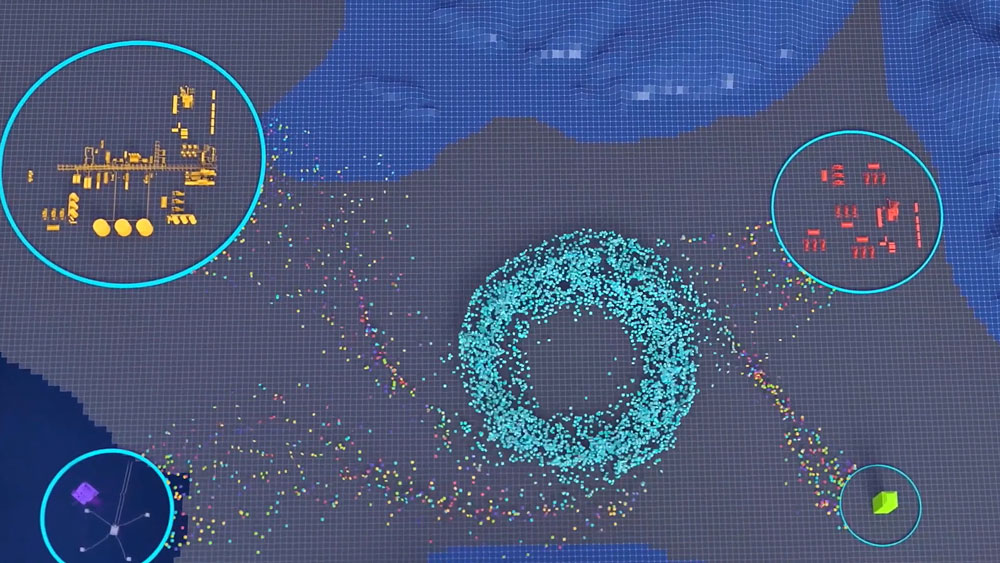Accelerating Adoption of Hybrid Cloud and Open Architectures in Oil and Gas
A new IBM-Red Hat-Schlumberger hybrid cloud accelerator will make operators more effective. The three parties entered into collaboration to accelerate digital transformation across the oil and gas industry.
The joint initiative will provide global access to Schlumberger’s leading exploration and production (E&P) cloud-based environment and cognitive applications by leveraging IBM’s hybrid cloud technology, built on the Red Hat OpenShift container platform.
The collaborative development will initially focus on two key areas:
- Private, hybrid or multi-cloud deployment of the DELFI cognitive E&P environment enabled by Red Hat OpenShift to significantly expand access for customers.
- Delivering the first hybrid cloud implementation of the OSDU™ data platform (the open data platform for the industry).
Through the agreement with IBM and Red Hat, Schlumberger has committed to the exclusive use of Red Hat OpenShift. Using the container platform will enable the deployment of applications in the DELFI environment across any infrastructure, from traditional data centers to multiple clouds, including private and public. This new way of hosting will offer the possibility to use multiple cloud providers and will address critical issues for customers, facilitating in-country deployments in compliance with local regulations and data residency requirements.
The DELFI environment incorporates cutting-edge data analytics and artificial intelligence, drawing upon multiple data sources, automating workflows, and facilitating seamless collaboration for domain teams. Many more oil and gas operators, suppliers and partners, from all regions of the world will be enabled to work from the industry’s leading digital environment—built on a standard, open platform—where they can ‘write once and run everywhere’ when creating new applications.
“By expanding market access to the DELFI environment we take a major step forward on the journey to establishing the open and flexible digital environment our industry needs,” comments Olivier Le Peuch, chief executive officer, Schlumberger. “Our collaboration with IBM and Red Hat complements our established digital partnerships to produce an industry-first solution to overcome our customers’ challenges. Together, we are enabling seamless access to a hybrid cloud platform in all countries across the globe for deployment in any basin, for any operator.”
“The logic, purpose, and differentiation of all businesses can now be rendered in code, which is why digital innovation has become the most powerful way to drive transformation and hybrid cloud is the lever that unleashes it,” said Arvind Krishna, chief executive officer, IBM. “Together with Schlumberger, we are empowering a much broader group of participants to play a role in driving that transformation and helping the energy industry solve some of the world’s toughest challenges to emerge stronger.”
“The energy industry is transforming as organizations look for efficient new ways to power their operations, adopt digital technologies to create a competitive advantage, and innovate and integrate workflows to make faster and better decisions,” said Paul Cormier, president and chief executive officer, Red Hat. “A hybrid cloud foundation built on open source offers the flexibility, acceleration and innovation this digital transformation requires. Schlumberger has long been an industry leader and is bold in its vision for digital transformation in the energy industry. We look forward to working closely with Schlumberger to make the DELFI environment available everywhere with Red Hat OpenShift.”
Schlumberger supports many of the world’s most vital oil and gas operations and is on the forefront of digitalization across the energy sector. It has established the DELFI environment as the industry-leading cognitive E&P environment where today energy professionals access open APIs to work together, independent of role, workflow or physical location, and create solutions that significantly improve business operations.
The organizations intend to further their collaboration with the creation of a differentiated data management and operations solution for the OSDU™ data platform, enabling oil and gas operators to build, deploy and transition digital solutions with hybrid-cloud data infrastructures. This will foster wider collaboration and greater efficiency across many professionals in the E&P value chain.
Prior to this announcement, Schlumberger, IBM and Red Hat successfully piloted the new hybrid cloud deployment of the DELFI environment on Red Hat OpenShift, the leading Kubernetes platform, working with Red Hat and IBM Services, the world’s largest team of Red Hat certified consultants. The two organizations focused on demonstrating the flexibility and portability for compute, storage and data intensive exploration and field development applications.
IBM’s collaboration with Schlumberger is part of the company’s new commitment to invest in accelerating adoption of hybrid cloud and open architectures. IBM is targeting essential industries, such as energy, running the crucial processes of the world. These efforts are increasing in importance as organizations navigate the impacts of the pandemic and economic downturn, which is creating an acute need for speed to market, flexibility and nimbleness to encourage innovation.
Manish Chawla, a member of IBM’s Industry Academy and IBM Global Managing Director for Energy & Natural Resources, along with Trygve Randen, Global Director Digital Subsurface Solutions, Schlumberger, explain what to expect from the collaboration and how it could accelerate the industry’s digital transition.
“At Schlumberger, to address the historical imbalance in global supply and demand for oil today, we ensure our performance partnerships include an eye toward digital technology, sustainability and New Energy. We view digital in two ways: the acceleration of digital adoption among our customers and across their workflows and operations; and second, the impact of digital on our own operations. This is why we are collaborating with IBM and Red Hat. Together we will expand and evolve an environment where energy professionals in all countries across the globe can collaborate using data and new software applications for digital innovation,” affirms Trygve Randen.
“In addition to IBM’s leadership in enterprise technology innovation, we also have a long history with clients in the energy industry. We have worked with Schlumberger for a number of years, supporting their efforts to drive efficiency in their enterprise functions, and helping many energy companies modernize their operations,” adds Manish Chawla.
The latest technology collaboration will help place new technology capabilities in the hands of many more energy companies, helping them to accelerate their digital transformation. This translates to more efficient operations, driving down costs for the consumer as well as enhancing safety and helping to reduce environmental impact through operations that have first been fully optimized digitally, before the physical extraction of oil and gas.
What is DELFI?
The ‘DELFI cognitive E&P environment’ is a secure, cloud-based software technology that enables team collaboration across the entire industry lifecycle. It is an open, scalable, and fully managed environment, seamlessly connecting people, data and leading software applications across exploration, development, drilling, production and midstream to produce a high fidelity and evergreen digital model for planning and operations.
User growth of DELFI has exceeded an impressive 400 percent since 2019. Still, while the platform offers access to a number of public clouds, half of the oil and gas companies of the world are unable to easily access these cloud platforms. This is due to constraints around data sovereignty, reach of public clouds and the specific architectural choices companies have employed.
“Within these boundaries we saw an opportunity to apply hybrid cloud built on open technologies. This allows for workload portability, orchestration and management across multiple infrastructure environments allowing the DELFI environment to be available across a variety of infrastructure choices. For example, in-country clouds, on-premise, and private clouds. In other words, it fosters an ecosystem where ideas from customers, suppliers and partners can be brought together and gain the benefits without being constrained by their location,” points out Manish Chawla.
Main challenges
A key aspect is capturing data. There’s a principle in the industrial world—“as designed, as built, as maintained”—that’s critical and has historically been under-developed in the exploration and production industry, explains Trygve Randen.
“Take the example of building a tunnel through a mountain. Once it’s built, is the design available, in all its gory detail, to whoever is going to maintain it? You’re constantly maintaining, upgrading, improving and operating, so that same data should be carrying through for the right people to access. Many processes in the industry—even something like finding and analyzing a seismic image underneath a location and deciding where to drill a well—requires multiple professionals, often working for different organizations. They’re all using different applications, and if you have to copy data from one application or database to the next, you can have distortions, errors. You can lose time,” he mentions.
“The mission-critical workloads that run large businesses and institutions often span extensive IT estates. In fact, the average company today draws data from more than 400 sources, and it can run as high as 1,000 sources or more. The idea is to create a single source of truth. We have shown that adopting a hybrid cloud architecture can be 2.5 times more valuable than relying on public cloud alone. Red Hat’s OpenShift allows customers to containerize their applications—essentially, to encapsulate them and make them cloud-portable. So, instead of needing to rewrite software code for each cloud provider, the code can be written once and encapsulated for use in any technology set-up. That includes traditional data centers as well as public, private and edge clouds. It helps open up a truly global market,” highlights Manish Chawla.
Open Subsurface Data Platform
The OSDU, or more precisely, the Open Group Open Subsurface Data Universe Forum is a cross-industry collaboration to develop a common, industry-standard and open basis for oil and gas data. Its output is free code as well as data standards that companies, organizations or specialist providers can use.
By streamlining access and use of data the industry expects to drive higher performance and greater efficiencies, including the use of new data-driven workflows and innovation using artificial intelligence.
Schlumberger announced in August last year that it would open-source its data ecosystem—part of the DELFI environment—and contribute it to the OSDU Forum to accelerate the delivery of the OSDU data platform.
Schlumberger is committed to supporting the ongoing development of the OSDU data platform, which together with the contributions of others will provide industry-leading capabilities, knowledge and experience.
About Red Hat
Red Hat is the world’s leading provider of enterprise open source software solutions, using a community-powered approach to deliver reliable and high-performing Linux, hybrid cloud, container, and Kubernetes technologies. Red Hat helps customers integrate new and existing IT applications, develop cloud-native applications, standardize on our industry-leading operating system, and automate, secure, and manage complex environments. Award-winning support, training, and consulting services make Red Hat a trusted adviser to the Fortune 500. As a strategic partner to cloud providers, system integrators, application vendors, customers, and open source communities, Red Hat can help organizations prepare for the digital future.
About IBM
IBM combines technology with industry expertise to help Oil & Gas clients digitally reinvent their businesses for resilience and sustainability. Pioneering advances in materials science from IBM Research accelerate energy transition. Data science and AI take the guesswork out of exploration. Predictive asset management raises production throughput. Supply chain insights and blockchain build trust and transparency across the downstream ecosystem. Customer experience experts reshape consumer connections at the gas pump or electric charge station. Through these solutions IBM helps Oil & Gas clients emerge smarter.







